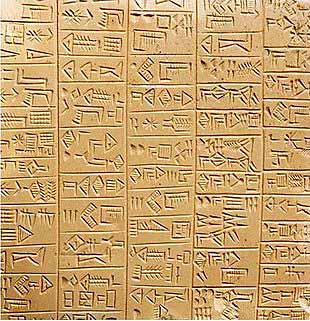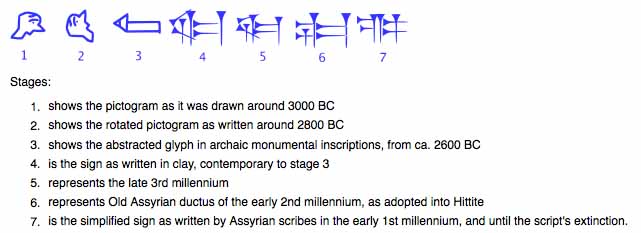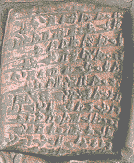

Cuneiform script is one of the earliest known forms of written expression. Emerging in Sumer around the 30th century BC, with predecessors reaching into the late 4th millennium (the Uruk IV period), cuneiform writing began as a system of pictographs. In the three millennia the script spanned, the pictorial representations became simplified and more abstract as the number of characters in use also grew gradually smaller, from about 1,000 unique characters in the Early Bronze Age to about 400 unique characters in Late Bronze Age (Hittite cuneiform).
The original Sumerian script was adapted for the writing of the Akkadian, Eblaite, Elamite, Hittite, Luwian, Hattic, Hurrian, and Urartian languages, and it inspired the Ugaritic and Old Persian alphabets. Cuneiform writing was gradually replaced by the Phoenician alphabet during the Neo-Assyrian Empire, and by the 2nd century AD, the script had become extinct.
Cuneiform documents were written on clay tablets, by means of a blunt reed for a stylus. The impressions left by the stylus were wedge shaped, thus giving rise to the name cuneiform ("wedge shaped", from the Latin cuneus, meaning "wedge").
The cuneiform writing system was in use for more than 35 centuries, through several stages of development, from the 34th century BC down to the 1st century AD. It was completely replaced by alphabetic writing (in the general sense) in the course of the Roman era and there are no Cuneiform systems in current use. For this reason, it had to be deciphered from scratch in 19th century Assyriology. Successful completion of decipherment is dated to 1857.
Cuneiform was written on clay tablets, on which symbols were drawn with a blunt reed called a stylus. The impressions left by the stylus were wedge shaped, thus giving rise to the name cuneiform, wedge-writing.The Sumerian script was adapted for the writing of the Akkadian, Elamite, Hittite, Assyrian, and Luwian languages, and inspired the Old Persian and Ugaritic national alphabets. It was widely used in Mesopotamia for about 3000 years, though the syllabic nature of the script as it was refined by the Sumerians was unintuitive to the Semitic speakers.
The system consists of a combination of logophonetic, consonantal alphabetic and syllabic signs
The cuneiform script underwent considerable changes over a period of more than two millennia. The image below shows the development of the sign SAG "head"


Development


Cuneiform pictograms were drawn on clay tablets in vertical columns with a pen made from a sharpened reed stylus. Then two developments made the process quicker and easier: People began to write from left to right in horizontal rows (rotating counter-clockwise all of the pictograms 90 ° in the process), and a new wedge-tipped stylus was used which was pushed into the clay, producing wedge-shaped ("cuneiform") signs. By adjusting the relative position of the tablet to the stylus, the writer could use a single tool to make a variety of impressions. The word "cuneiform" comes from the Latin word cuneus, meaning "wedge".
Cuneiform tablets could be fired in kilns to provide a permanent record, or they could be recycled if permanence was not called for. Many of the tablets found by archaeologists were preserved because they were baked when attacking armies burned the building in which they were kept.
This fact, before Sumerian civilization was rediscovered, prompted many philologists to suspect a precursor civilization to the Babylonian.Most later adaptations of Sumerian cuneiform preserved at least some aspects of the Sumerian script. Written Akkadian included phonetic symbols from the Sumerian syllabary, together with logograms that were read as whole words.
Many signs in the script were polyvalent, having both a syllabic and logographic meaning. When the cuneiform script was adapted to writing the Hittite language, a layer of Akkadian logographic spellings was added to the script, with the result that we no longer know the pronunciations of many Hittite words conventionally written by logograms.
The complexity of the system bears a resemblance to classical Japanese, written in a Chinese derived script; some of these Sinograms were used as logograms, others as phonetic characters. Contemporary Japanese graphically distinguishes the logograms (kanji) from syllabary characters (kana) but otherwise retains a similar system.
The complexity of the system prompted the development of a number of simplified versions of the script. Old Persian was written in a subset of simplified cuneiform characters, that formed a simple, semi-alphabetic syllabary, using far fewer wedge strokes than Assyrian used, together with a handful of logograms for frequently occurring words like "god" and "king." The Ugaritic language was written using the Ugaritic alphabet, a standard Semitic style alphabet (an abjad) written using the cuneiform method.
The use of Aramaic became widespread under the Assyrian Empire and the Aramaean alphabet gradually replaced cuneiform. The last known cuneiform inscription, an astronomical text, was written in 75 AD.
Cuneiform has a specific format for transliteration. Because of the script's polyvalence, transliteration is not only lossless, but may actually contain more information than the original document. For example, the sign DINGIR in a Hittite text may represent either the Hittite syllable an or may be part of an Akkadian phrase, representing the syllable il, or it may be a Sumerogram, representing the original Sumerian meaning, 'the creator'. The Sumerian deity Enki, meaning Lord of the Earth, was believed to have fashioned the earliest human prototype.
The cuneiform script is one of the earliest known forms of written expression. Created by the Sumerians from ca. the 34th century BC, cuneiform writing began as a system of pictographs. Over time, the pictorial representations became simplified and more abstract. Cuneiforms were written on clay tablets, on which symbols were drawn with a blunt reed called a stylus. The impressions left by the stylus were wedge shaped, thus giving rise to the name cuneiform ("wedge shaped").The Sumerian script was adapted for the writing of the Akkadian, Elamite, Hittite (and Luwian), Hurrian (and Urartian) languages, and it inspired the Old Persian and Ugaritic national alphabets.
Originally, pictograms were drawn on clay tablets in vertical columns with a pen made from a sharpened reed stylus, or incised in stone. This archaic style was still lacking the characteristic wedge-shape of the strokes.
From about 2900 BC, the pictographs began to lose their original function, and a given sign could have various meanings depending on context. The sign inventory was reduced from some 1,500 signs to some 600 signs, and writing became increasingly phonological. Determinative signs were re-introduced to avoid ambiguity. This process is directly parallel to, and probably not independent of, the development of Egyptian hieroglyphic orthography.
In the mid-3rd millennium, writing direction was changed to left to right in horizontal rows (rotating all of the pictograms 90 ° counter-clockwise in the process), and a new wedge-tipped stylus was used which was pushed into the clay, producing wedge-shaped ("cuneiform") signs; these two developments made writing quicker and easier. By adjusting the relative position of the tablet to the stylus, the writer could use a single tool to make a variety of impressions. The word "cuneiform" comes from the Latin word cuneus, meaning "wedge".
Cuneiform tablets could be fired in kilns to provide a permanent record, or they could be recycled if permanence was not needed. Many of the tablets found by archaeologists were preserved because they were baked when attacking armies burned the building in which they were kept.
The script was also widely used on commemorative stelae and carved reliefs to record the achievements of the ruler in whose honour the monument had been erected.Cuneiform was first used by the Babylonians and later on was adapted and used by the Assyrians.
Invented by the Babylonians to record the Sumerian language, cuneiform was subsequently adopted by the Akkadians, Elamites, Hittites and Assyrians to write their own languages and was widely used in Mesopotamia for about 3000 years, though the syllabic nature of the script as it was refined by the Sumerians was unintuitive to the Semitic speakers. This fact, before Sumerian civilization was rediscovered, prompted many philologists to suspect a precursor civilization to the Babylonian.
Most later adaptations of Sumerian cuneiform preserved at least some aspects of the Sumerian script. Written Akkadian included phonetic symbols from the Sumerian syllabary, together with logograms that were read as whole words. Many signs in the script were polyvalent, having both a syllabic and logographic meaning. When the cuneiform script was adapted to writing the Hittite language, a layer of Akkadian logographic spellings was added to the script, with the result that we no longer know the pronunciations of many Hittite words conventionally written by logograms. The complexity of the system bears a resemblance to classical Japanese, written in a Chinese-derived script; some of these Sinograms were used as logograms, others as phonetic characters. Modern Japanese graphically distinguishes the logograms (kanji) from syllabary characters (kana) but otherwise retains a similar system.
The complexity of the system prompted the development of a number of simplified versions of the script. Old Persian was written in a subset of simplified cuneiform characters, that formed a simple, semi-alphabetic syllabary, using far fewer wedge strokes than Assyrian used, together with a handful of logograms for frequently occurring words like "god" and "king." The Ugaritic language was written using the Ugaritic alphabet, a standard Semitic style alphabet (an abjad) written using the cuneiform method.
The use of Aramaic became widespread under the Assyrian Empire and the Aramaean alphabet gradually replaced cuneiform. The last known cuneiform inscription, an astronomical text, was written in AD 75.
Knowledge of cuneiform was lost until 1835 when Henry Rawlinson, a British army officer, found some of the Behistun inscriptions on a cliff at Behistun in Persia. Carved in the reign of King Darius of Persia (522 BC-486 BC), they consisted of identical texts in the three official languages of the empire: Old Persian, Babylonian, and Elamite. The Behistun inscription was to the decipherment of cuneiform what the Rosetta Stone was to the decipherment of Egyptian hieroglyphs.
Rawlinson correctly deduced that the Old Persian was a syllabic script and he successfully deciphered it. Working independently of him, the Irish Assyriologist Edward Hincks also contributed to the decipherment. After translating the Persian, Rawlinson and Hincks began to decipher the others. They were greatly helped by Paul Emile Botta's discovery of the city of Niniveh in 1842. Among the treasures uncovered by Botta were the remains of the great library of Assurbanipal, a royal archive containing tens of thousands of baked clay tablets covered with cuneiform inscriptions.
By 1851, Hincks and Rawlinson could read 200 Babylonian signs. They were soon joined by two other decipherers: a young German-born scholar called Julius Oppert, and the versatile British Orientalist William Henry Fox Talbot. In 1857 the four men met in London and took part in a famous experiment to test the accuracy of their decipherments.
Edwin Norris, the secretary of the Royal Asiatic Society, gave each of them a copy of a recently discovered inscription from the reign of the Assyrian emperor Tiglath-Pileser I. A jury of experts was empanelled to examine the resulting translations and assess their accuracy.
In all essential points the translations produced by the four scholars were found to be in close agreement with one another. There were of course some slight discrepancies. The inexperienced Talbot had made a number of mistakes, and Oppert's translation contained a few doubtful passages due to his unfamiliarity with the English language. But Hincks' and Rawlinson's versions were virtually identical. The jury declared itself satisfied, and the decipherment of Akkadian cuneiform was adjudged a fait accompli.
Cuneiform has a specific format for transliteration. Because of the script's polyvalence, transliteration requires certain choices of the transliterating scholar, who must decide in the case of each signal which of its several poseable meanings is intended in the original thing. For example, the sign DINGIR in a Hittite text may represent either the Hittite syllable an or may be part of an Akkadian phrase, representing the syllable il, it may be a Sumerogram, representing the original Sumerian meaning, 'god' or the determinative for a deity. In transliteration, a different rendition of the same glyph is chosen depending on its role in the present context.
Therefore, a text containing DINGIR and MU in succession could be construed to represent the words "ana", "ila", god + "a" (the accusative ending), god + water, or a divine name "A" or Water. Someone transcribing the signs would make the decision how the signs should be read and assemble the signs as "ana", "ila", "Ila" ('god"+accusative case), etc. A transliteration of these signs, however, would separate the signs with dashes "il-a", "an-a", "DINGIR-a" or "Da". This is still easier to read than the original cuneiform, but now the reader is able to trace the sounds back to the original signs and determine if the correct decision was made on how to read them. A transliterated document thus presents both the reading preferred by the transliterating scholar as well as the opportunity to reconstruct the original text.
There are differing conventions for transliterating Sumerian, Akkadian (Babylonian) and Hittite (and Luwian) cuneiform texts. One convention that sees wide use across the different fields is the use of acute and grave accents as an abbreviation for homophone disambiguation. Thus, u is equivalent to u1, the first glyph expressing phonetic u. An acute accent, u, is equivalent to the second, u2, and a grave accent u to the third, u3 glyph in the series (while the sequence of numbering is conventional but essentially arbitrary and subject to the history of decipherment). In Sumerian transliteration, a multiplication sign 'x' is used to indicate ligatures.
As shown above, signs as such are represented in capital letters, while the specific reading selected in the transliteration is represented in small letters. Thus, capital letters can be used to indicate a so-called Diri compound - a sign sequence that has, in combination, a reading different from the sum of the individual constituent signs (for example, the compound IGI.A - "water" + "eye" - has the reading imhur, meaning "foam"). In a Diri compound, the individual signs are separated with dots in transliteration. Capital letters may also be used to indicate a Sumerogram (for example, KUG.BABBAR - Sumerian for "silver" - being used with the intended Akkadian reading kaspum, "silver"), an Akkadogram, or simply a sign sequence of whose reading the editor is uncertain. Naturally, the "real" reading, if it is clear, will be presented in small letters in the transliteration: IGI.A will be rendered as imhur4.
Since the Sumerian language has only been widely known and studied by scholars for approximately a century, changes in the accepted reading of Sumerian names have occurred from time to time. Thus the name of a king of Ur, read Ur-Bau at one time, was later read as Ur-Engur, and is now read as Ur-Nammu or Ur-Namma; for Lugal-zaggisi, a king of Uruk, some scholars continued to read'; and so forth. Also, with some names of the older period, there was often uncertainty whether their bearers were Sumerians or Semites.
If the former, then their names could be assumed to be read as Sumerian, while, if they were Semites, the signs for writing their names were probably to be read according to their Semitic equivalents, though occasionally Semites might be encountered bearing genuine Sumerian names. There was also doubt whether the signs composing a Semite's name represented a phonetic reading or a logographic compound. Thus, e.g. when inscriptions of a Semitic ruler of Kish, whose name was written Uru-mu-ush, were first deciphered, that name was first taken to be logographic because uru mu-ush could be read as "he founded a city" in Sumerian, and scholars accordingly retranslated it back to the original Semitic as Alu-usharshid. It was later recognized that the URU sign can also be read as ri and that the name is that of the Akkadian king Rimush. Read more

Digital cuneiforms: Updated tool expands access to ancient Hittite texts PhysOrg - March 26, 2025
The cuneiform tablets discovered in norther Turkey and other Hittite sites represent one of the largest groups of texts from the ancient Near East. They include thousands of sources in Hittite, an early-attested Indo-European language, as well as numerous fragments in other Anatolian languages, alongside Sumerian, Akkadian, and Hurrian texts.